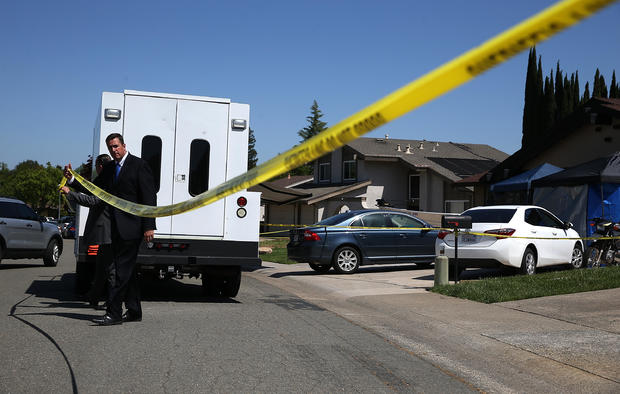Search for "Golden State Killer" led to wrong man in 2017
SACRAMENTO, Calif. -- Investigators hunting down the so-called "Golden State Killer" used information from genetic websites last year that led to the wrong man, court records obtained Friday by The Associated Press showed. An Oregon police officer working at the request of California investigators persuaded a judge to order a 73-year-old man in an Oregon City nursing home to provide a DNA sample.
It's not clear if officers collected the sample and ran further tests, but it was not the man arrested this week outside Sacramento in one of the state's most notorious string of serial rapes and killings.
The case of mistaken identity was discovered as authorities hailed a novel use of DNA technology that led this week to the arrest of former police officer Joseph DeAngelo at his house outside Sacramento on murder charges. He's suspected of being the sadistic attacker who killed 13 people and raped nearly 50 women during the 1970s and '80s.
Handcuffed to a wheelchair in orange jail scrubs, DeAngelo made his first court appearance Friday. The 72-year-old looked dazed and spoke in a faint voice to acknowledge he was represented by a public defender. He did not enter a plea.
He has been charged with eight counts of murder, and additional charges are expected, authorities said.
Investigators were able to make the arrest after matching crime-scene DNA with genetic material stored in an online database by a distant relative. They relied on a different website than they had in the Oregon search, and they did not seek a warrant for DeAngelo's DNA.
Instead, they waited for him to discard items and then swabbed the objects for DNA, which proved a conclusive match to the evidence that had been preserved more than 30 years.
Also Friday, the co-founder of the genealogy website used by authorities said he had no idea its database was tapped in pursuit of the suspect who eluded law enforcement for four decades.
Authorities never approached Florida-based GEDmatch about the investigation that led to DeAngelo, and co-founder Curtis Rogers said law enforcement's use of the site raised privacy concerns that were echoed by civil liberties groups.
The free genealogy website, which pools DNA profiles that people upload and share publicly to find relatives, said it has always informed users its database can be used for other purposes. But Rogers said the company does not "hand out data."
"This was done without our knowledge, and it's been overwhelming," he told The Associated Press.
In 2017, "48 Hours" investigated a case in which a public DNA database pointed police in Idaho to a New Orleans filmmaker in the 1996 murder of Angie Dodge. Idaho Falls Police obtained a court order to obtain the identity of the person who submitted a profile -- which was a "partial" match to their suspect DNA profile -- from Ancestry.com, which had acquired the database. Police honed in on the filmmaker -- the son of the man they identified -- as a possible suspect, but when they obtained a DNA sample from him, he was cleared.
The story raised serious questions about what happens when police use publicly available DNA databases to solve cases – and what happens when an innocent man is tagged as a suspect.
For the team of investigators, GEDmatch was one of the best tools, lead investigator Paul Holes told the Mercury News in San Jose.
Officials did not need a court order to access GEDmatch's large database of genetic blueprints, Holes said. Major commercial DNA companies say they do not give law enforcement access to their genetic data without a court order.
Civil libertarians said the practice raises legal and privacy concerns for the millions of people who submit their DNA to such sites to discover their heritage.
There are not strong privacy laws to keep police from accessing ancestry site databases, said Steve Mercer, the chief attorney for the forensic division of the Maryland Office of the Public Defender.
"People who submit DNA for ancestors testing are unwittingly becoming genetic informants on their innocent family," Mercer said, adding that they "have fewer privacy protections than convicted offenders whose DNA is contained in regulated databanks."
While people may not realize police can use public genealogy websites to solve crimes, it is probably legal, said Erin Murphy, a DNA expert and professor at New York University School of Law.
"It seems crazy to say a police officer investigating a very serious crime can't do something your cousin can do on a Tuesday," Murphy said. "If an ordinary person can do this, why can't a cop? On the other hand, if an ordinary person had done this, we might think they shouldn't."
While most consumers would have to get a genetic profile from a commercial company such as Ancestry.com and 23andMe, the police may have obtained the DNA profile in their crime lab before uploading it to GEDmatch, she said.
DNA was just coming into use as a criminal investigative tool in 1986 when the predator also known as the East Area Rapist apparently ended his decade-long wave of attacks.
As a former police officer, DeAngelo probably would have known about the new method, experts said.
Police at the time suspected they were chasing a fellow cop or armed services member because he was so methodical and meticulous, said Wendell Phillips, a former Sacramento deputy who joined the hunt for the rapist who terrorized the suburbs east of the state capital.
In fact, officers assigned to a special task force were required to submit saliva samples to exclude anyone who shared a genetic trait, Phillips said. About 85 percent of people secrete their blood type in saliva and body fluids, but the rape suspect was in the roughly 15 percent who didn't.
"Obviously, you didn't want the East Area Rapist on the team," Phillips said. "That turned out to be a pretty good concern."




